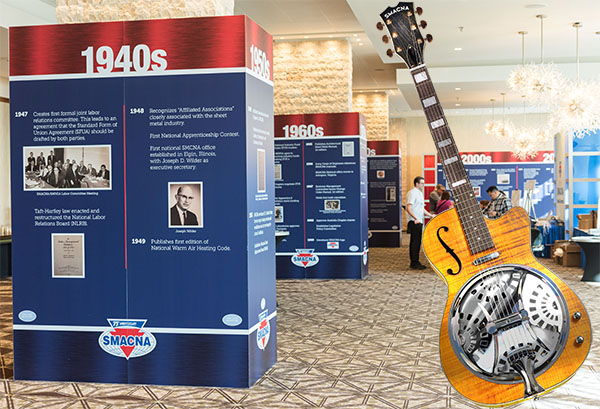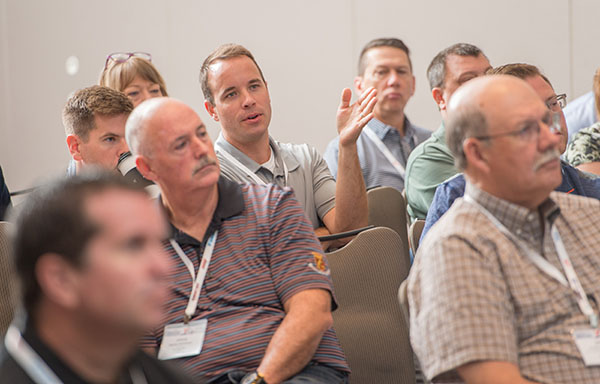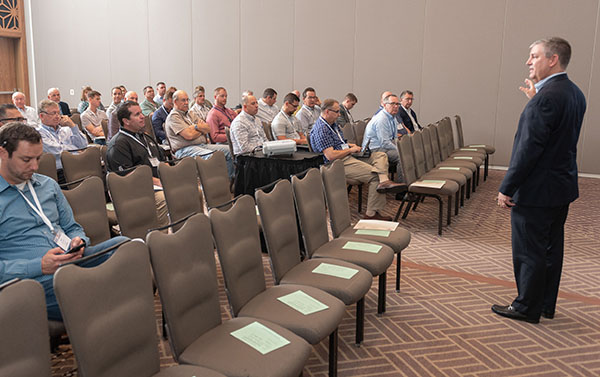
Sheet metal and air conditioning contractors from across the United States gathered in Austin, Texas, from Oct. 20-23 to celebrate the 75th Anniversary of SMACNA and to get the latest updates on economic, technology and construction industry trends.
The event offered a variety of opportunities for industry professionals to socialize and network with their peers too, including at a performance by the legendary rockers of Foreigner. Meanwhile, attendees could take advantage of a range of educational programming covering some of the most pressing issues currently facing sheet metal and HVAC companies today.
Technology and an evolving workforce were among the most popular topics of conversation throughout the convention.
Technology
Numerous educational sessions during the event keyed in on the impact of technology on the contracting sector.
At one presentation, Clark Ellis, principal and founding partner with Continuum Advisory Group, gave an overview of the so-called Internet of Things and its implications for sheet metal and HVAC contractors. Ellis discussed the evolution of building systems and the coming changes for contractors, noting that “plug-and-play” technologies requiring little attention from users are helping accelerate the pace of change in the sector. For example, builders can now use sensors that offer an expanding variety of functions and have the power to capture more significant amounts of data.
Similarly, Heath May, principal and director of HKS Laboratory for INtensive Exploration, led a forum on disruptive trends and technologies. May’s presentation focused on enhancing value by improving effectiveness and efficiency in design and project delivery. He highlighted the benefits of using digital design and fabrication and keeping everything as print-free as possible. Even using a model digitally to legally represent the project in the permitting process.
May talked about the progress of technology and how how automation, mass production, and assembly have been around for a long time and the world is already moving beyond computers and automation in the news realm of AI, and robotics. May left attendees with a thought on technology. “Whether or not we use technology is one thing, but being prepared to deal with it and understanding how it’s being used and how it is impacting you is another.
An extended session on Oct. 22 highlighted some of the latest technological developments and products affecting the HVAC and sheet metal industry. For example, Daikin Applied gave a presentation on the future of refrigerants and Titus discussed cutting-edge worker training. Additionally, Innovative Construction Technology showcased its ICT Tracker, an app utilizing 3D models to document installation data.
Another educational session delved into practical applications and best practices for architectural building enclosures and wall panel systems. SMACNA contractor Jordan Thomas, vice president of New Jersey-based Thomas Company Inc., offered thoughts on the different types of wall panel systems currently on the market and being used for prefabrication. Meanwhile, Dan McCallum, a member of the International Training Institute’s (ITI) field training staff, highlighted the importance of education and training for building enclosure systems. McCallum said utilizing training programs that offer concentrated instruction on specific skills before projects start can save significant time for contractors once construction work actually begins.

Attendees took advantage of a range of session topics covering the most pressing issues to contractors.
Another session explored leading concerns in cybersecurity. Matrix Group CEO Joanna Pineda and Heinan Landa, the founder and CEO of Optimal Networks, dissected social engineering, which refers using human manipulation and errors to launch cyberattacks. The pair also provided advice on tools to protect companies against hacks and how companies can evaluate their own cybersecurity protocols.
Additionally, author Beth Ziesenis offered a research-based assessment of some of the most common productivity problems facing workers today. She also provided tips on useful solutions and technologies to help overcome the hurdles standing in the way of boosting productivity. Apps she mentioned include Plan, Trellow, SmartSheet,Doodle, X.ai, and Google Assistant.
Policy and Politics
As campaigns for the 2020 elections begin to heat up, the latest developments in policy and politics garnered plenty of attention during the convention. Stanley E. Kolbe Jr., SMACNA’s director of legislative affairs, and Erykka Thompson, SMACNA’s assistant director of legislative affairs, delivered an overview of the political landscape. They focused primarily on the issues of utmost importance to contractors and construction companies in the institutional, residential, commercial and industrial markets — including tax issues; pension, labor, and management issues; and energy retrofitting initiatives.

Kolbe and Thompson highlighted some of the latest developments with SMACNA’s political action committee, SMAC PAC, noting that member participation and funding have both enjoyed significant growth in 2019. Thompson broke down the rationale behind the PAC’s contributions to more than 70 candidates in the 2020 elections, pointing out that the PAC has targeted dozens of incumbents in what are considered “highly competitive” races.
Changes to the Labor Force
One of the more notable sessions delved into transitions in the construction workforce and strategies for retaining skilled labor. FMI Corporation Managing Director Jay Bowman offered his take on the challenges of transferring an older generation’s “tribal knowledge” built up over careers to younger construction workers.
Bowman said the companies best prepared for the generational shift have high degrees of organizational consistency. Those companies helped foster that consistency by minimizing voluntary turnover among their employees. They excelled in boosting employee engagement by offering defined roles to employees, providing development opportunities, creating learning environments and communicating consistent feedback.
Similarly, a panel on Oct. 21 focused on joint apprenticeship training committees (JATCs) and related topics such as recruitment, training and educational curricula. Participants included Worcester Air Conditioning President and CEO James Morgan; General Sheet Metal Owner and CEO Carol Duncan; Andrew Gilliland, a training coordinator with the Colorado Sheet Metal Institute; and Tom Montgomery, general manager with ACCO Engineered Systems.
Montgomery said ACCO is starting to reap the benefits of its efforts to recruit women to join the construction sector. In one case, the company has partnered with an outside program to groom female candidates for jobs in the industry through what he described as “pre-apprenticeships” in which they learn skills on actual job sites.
An early presentation for HVAC contractors on Oct. 21 covered leadership development in the construction industry. DeWayne Ables, the founder and president of Pioneer IQ, ran an interactive workshop on 10 behaviors aimed at helping workplace leaders inspire their teams. Ables also led a session on guidelines for managers to compose high-performing teams from among their employees.
Another session outlined the benefits of SMART MAP training for evaluating employees’ mental and physical wellbeing. The presentation from Chris Carlough, education director of the SMART Union, touched on drug and alcohol use on and off the job site, suicide and finding quality treatment for addiction and mental health concerns. Carlough also discussed issues surrounding legalizing marijuana in some states.